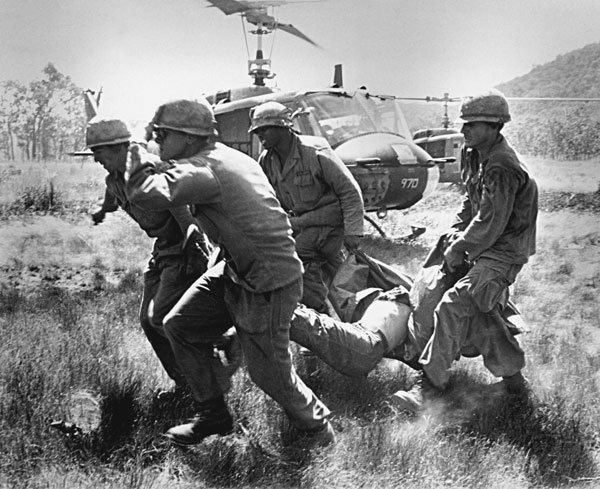No one expected such a shy and gentle man to play a major role
in American history.
But, Gilroyan James W. Ervin wasn’t asking to be a hero.
He was just the victim of the unfortunate circumstances of the
first major battle in Vietnam.
No one expected such a shy and gentle man to play a major role in American history.
But, Gilroyan James W. Ervin wasn’t asking to be a hero.
He was just the victim of the unfortunate circumstances of the first major battle in Vietnam.
The battle of Ia Drang was the first time U.S. forces and the North Vietnamese Army would confront each other. Although both sides declared victory, the Americans suffered severe casualties, losing 234 men in four days, including Ervin.
His name is listed in the dedication of the 1993 book “We Were Soldiers, Once … and Young,” by Lt. Gen. Harold G. Moore and Joseph L. Galloway. It’s the basis for the 2001 movie starring Mel Gibson. That’s all the mention James W. Ervin receives in the book’s 535 pages.
But he isn’t forgotten.
“Who could forget the Vietnam War?” his niece Elaine Pittroff said. “It’s synonymous with ‘Uncle Jimmy.'”
His sister, Edna Marrujo, who still resides in Gilroy, and her two daughters Pittroff, of San Jose, and Phyllis Armenta, of Gilroy, remember Ervin as a man of contradictions: He spoke rarely, yet was a constant letter writer; he was kind and gentle, yet a career soldier.
“He was a quiet man, but wrote letters faithfully,” Pittroff said. “He especially liked cookies sent to him.”
At age 17, Ervin graduated from high school in Porterville, 70 miles south of Fresno – although he had attended Gilroy schools for years – and joined the Army. Because he was so young, he needed parental permission, which he got from his father.
“His love of and responsibility to country was very, very important to him,” Pittroff said. “I am sure that he was affected by the second World War.”
Ervin was a military man through and through, Pittroff said. He sent his nieces extravagant gifts from the places he was stationed, such as silk slippers, delicate tea sets and embroidered kimonos from Japan.
“I think he really enjoyed us,” Pittroff said.
He took particular pleasure in spoiling his nieces because he didn’t have a wife or any children of his own – yet.
Instead, he focused on his Army career, which, like his rank, had its ups and downs.
For a while, he worked as a quartermaster, an officer responsible for the food, clothing and equipment of troops at Fort Ord, north of Monterey.
“He switched over (to infantry) to see action, and I guess he did,” Marrujo said.
At age 36 in 1965, Ervin was less than two years from retirement after a life-long career in the Army, and his new wife, Audrey, was pregnant with their daughter in Fort Benning, Ga.
“He was thinking of retiring, because he had a family on the way,” Armenta said.
But he wrote Pittroff on Aug. 17, 1965 to tell her he was being deployed to Vietnam. He was a sergeant in the anti-tank division, but because there were no tanks in the Ia Drang Valley, he led a platoon of mortar men.
The first few months were relatively calm as he likely spent much of his time patrolling. But things suddenly heated up in the jungle.
On Nov. 17, 1965, the men of the 2nd Battalion, 7th Cavalry, exhausted after two sleepless days, received orders to march from landing zone X-Ray to landing zone Albany. En route, the men stopped for 20 minutes while two prisoners were interrogated. They were unaware that nearby the 8th Battalion of the 66th People’s Army Regiment was also taking a break along the Ia Drang River.
Robert Towles, of Windham, Ohio, was among the soldiers ambushed by the North Vietnamese.
“We were attacked shortly after 1 o’clock. The vast majority of the casualties occurred within the first 10 to 15 minutes on our side,” Towles said.
He remembered looking back and seeing Ervin’s platoon consumed by a wave of North Vietnamese soldiers. He figures Ervin probably died within those first few minutes.
The situation was chaos. The North Vietnamese were hiding in the trees and among the Americans. As they tried to fight back, some of the Americans were struck by friendly fire.
They were only 100 yards from landing zone Albany. No one knows for sure why the soldiers were told to rest instead of advancing to secure the landing zone, Towles said. Another mystery is why no helicopters brought in reinforcements from a nearby camp. Towles said he heard something about a gasoline shortage.
The battalion lost 155 men, with 125 wounded and at least five missing in action in this, the fourth and bloodiest day of the 34-day Ia Drang Campaign. Towles suffered multiple shrapnel wounds. For his service, he was awarded the Bronze Star for valor and a Purple Heart.
In their book, Galloway and Moore call the Ia Drang Campaign a “dress rehearsal” for the United State’s new air airmobile warfare and weaponry.
“The U.S. declared victory by holding the battlefield,” Towles said. But the North Vietnamese claimed victory because the Americans suffered more casualties.
“They learned more from it. They learned our tactics, they learned how to fight us by getting right in there amongst us. And that defeated our use of air power and artillery. That caused a tremendous amount of casualties,” Towles said.
Less than a month after Ervin’s body was brought back to American soil, a new life began. His daughter Jamie – whom his family has never met – was born. Ervin’s wife since remarried and lives in Georgia. Jamie followed in her father’s footsteps and joined the Army.
The realization that he was really gone set in for his family in California when the letters stopped coming. His last letter to Pittroff was dated Oct. 19, 1965.
“He asked me in his last letter for some cookies,” she said. “I put that off. I truly regret putting off sending those cookies. Chocolate chip, I recall.”













